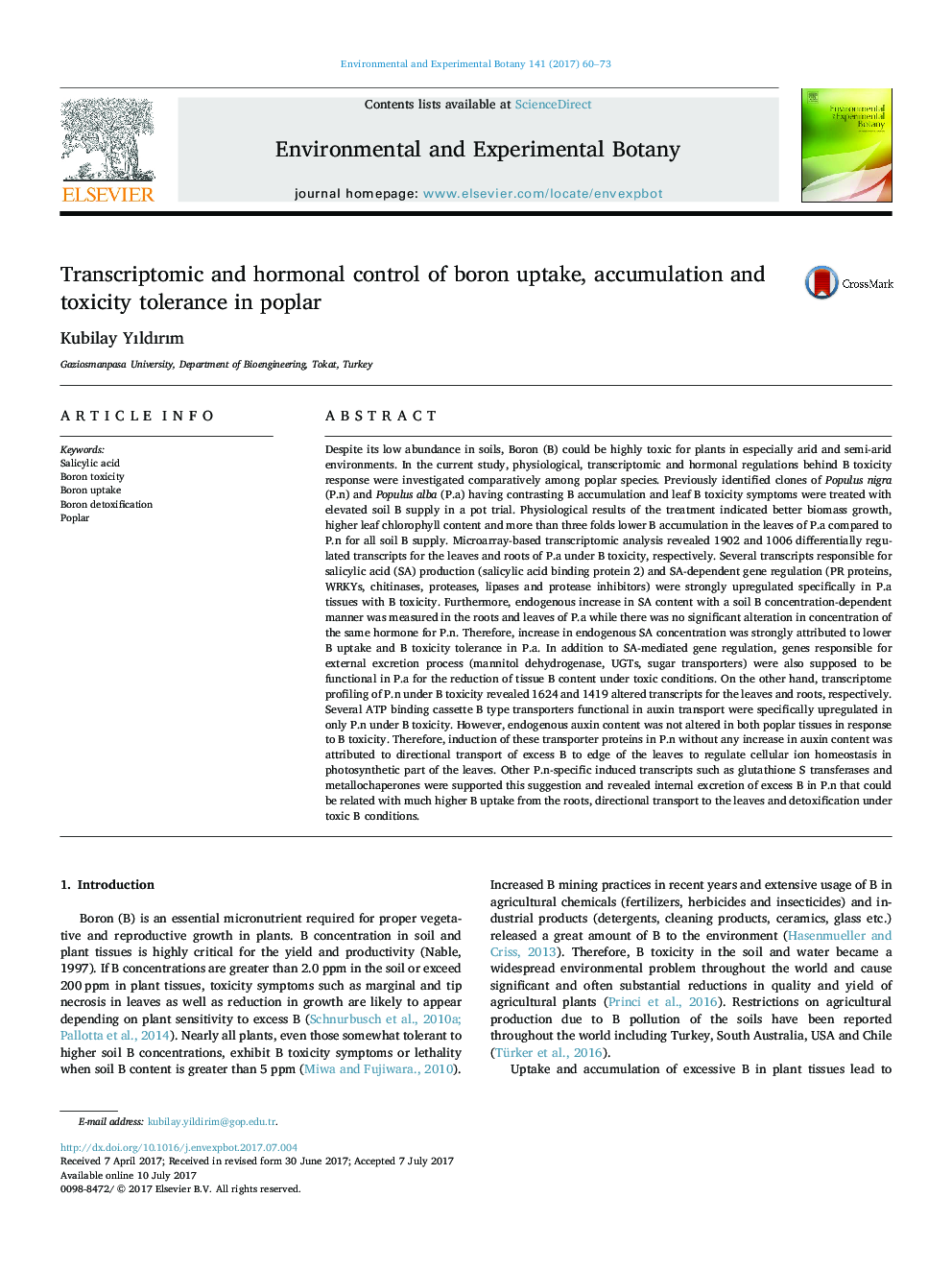| کد مقاله | کد نشریه | سال انتشار | مقاله انگلیسی | نسخه تمام متن |
|---|---|---|---|---|
| 5766601 | 1628036 | 2017 | 14 صفحه PDF | دانلود رایگان |
- P. alba accumulated much lower B compared to P. nigra under soil B toxicity.
- SA mediated gene regulation linked to lower B uptake and accumulation.
- SA mediated hypersensitive response attributed to leaf B toxicity symptoms of P. alba.
- Genes related with external excretion of excess B were defined in P. alba.
- P. nigra induced the genes functional in B uptake, transport and detoxification.
Despite its low abundance in soils, Boron (B) could be highly toxic for plants in especially arid and semi-arid environments. In the current study, physiological, transcriptomic and hormonal regulations behind B toxicity response were investigated comparatively among poplar species. Previously identified clones of Populus nigra (P.n) and Populus alba (P.a) having contrasting B accumulation and leaf B toxicity symptoms were treated with elevated soil B supply in a pot trial. Physiological results of the treatment indicated better biomass growth, higher leaf chlorophyll content and more than three folds lower B accumulation in the leaves of P.a compared to P.n for all soil B supply. Microarray-based transcriptomic analysis revealed 1902 and 1006 differentially regulated transcripts for the leaves and roots of P.a under B toxicity, respectively. Several transcripts responsible for salicylic acid (SA) production (salicylic acid binding protein 2) and SA-dependent gene regulation (PR proteins, WRKYs, chitinases, proteases, lipases and protease inhibitors) were strongly upregulated specifically in P.a tissues with B toxicity. Furthermore, endogenous increase in SA content with a soil B concentration-dependent manner was measured in the roots and leaves of P.a while there was no significant alteration in concentration of the same hormone for P.n. Therefore, increase in endogenous SA concentration was strongly attributed to lower B uptake and B toxicity tolerance in P.a. In addition to SA-mediated gene regulation, genes responsible for external excretion process (mannitol dehydrogenase, UGTs, sugar transporters) were also supposed to be functional in P.a for the reduction of tissue B content under toxic conditions. On the other hand, transcriptome profiling of P.n under B toxicity revealed 1624 and 1419 altered transcripts for the leaves and roots, respectively. Several ATP binding cassette B type transporters functional in auxin transport were specifically upregulated in only P.n under B toxicity. However, endogenous auxin content was not altered in both poplar tissues in response to B toxicity. Therefore, induction of these transporter proteins in P.n without any increase in auxin content was attributed to directional transport of excess B to edge of the leaves to regulate cellular ion homeostasis in photosynthetic part of the leaves. Other P.n-specific induced transcripts such as glutathione S transferases and metallochaperones were supported this suggestion and revealed internal excretion of excess B in P.n that could be related with much higher B uptake from the roots, directional transport to the leaves and detoxification under toxic B conditions.
Journal: Environmental and Experimental Botany - Volume 141, September 2017, Pages 60-73
